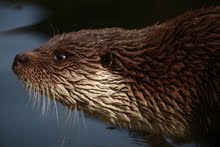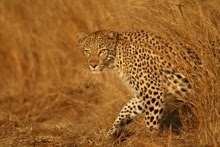I have now been back in South Africa for a few days. After landing in Johannesburg on Thursday, my brother and I had a quick cup of tea with our long-time friend
Graham Kearney (the absolutely brilliant wildlife artist) and then headed off South for the 4hour drive down to Bloemfontein in the Free State.
The drive from Johannesburg to Bloemfontein takes one through the large open expanses of the „Highveld Grasslands“ – dry and sleeping in a state of torpor, shades of winter browns filling the landscape. Nearing Bloemfontein, the eye is drawn to the rusty Koppies littering the horizon. Koppies (literally „little heads“) are these small mountains, rising steeply from a flat plain, dominated by boulders and small cliffy sections and usually sporting a flat plateau.
 The wide open plains of the Free State
The wide open plains of the Free StateIt is wonderful to be back in Africa.
My 90yr old grandmother (Oma) had knitted scarfs, a jersey and house socks for me and nearly had a heart-attack with excitement when she first saw my brother and I (Barry had also just gotten back from working in China). The folks were naturally also well pleased to have both of us back in South Africa and all together again.
My first evening back, I gave a talk at BirdLife Free State and it was wonderful to meet such an enthusiastic and friendly crowd of bird and nature lovers, and it was great to see Rick Nuttall again after so many years. Rick and Birdlife Free State are really in to the
Southern African Bird Atlas Project 2 (SABAP2) – a grassroots bird serveying and sensusing project run throughout Southern Africa. One of the coolest things about SABAP2 is that you can see your data almost in real time as you add it.
Check out the website to see the map of sightings of the Lesser Kestrel (by way of example).
 I know I can do it! I will not fall. Just watch me. mmm... I wonder if I can find an even smaller branch to perch on?
I know I can do it! I will not fall. Just watch me. mmm... I wonder if I can find an even smaller branch to perch on?
Yesterday we took a drive out towards Maselspoort Dam. I naturally took my digiscoping setup with – just in case. We saw tons of Blackbellied Korhaans, some Whitefronted Bee-eaters and Spotted Dikkops, the ubiquitous flocks of little brown jobs (LBJ’s – mainly widos, bishops and redbilled queleas) and a good number of Crowned Plovers. We also came across a group of the cooperative breeding Anteating Chat, and a pair of Doublebanded Coursers.
 Doublebanded Courser (Rhinoptilus africanus) - my brother's first digiscoping photo. Not bad at all - the boy has a massive creative streak and more than a small dose of brilliance.
Doublebanded Courser (Rhinoptilus africanus) - my brother's first digiscoping photo. Not bad at all - the boy has a massive creative streak and more than a small dose of brilliance.
The great surprise of the day was to find some sort of game farm along the road with lions, including my first White Lions – the famous leucocystic white lions of Timbavati. Beautiful.
 A stunning male white lion
A stunning male white lion



























.jpg)



.jpg)








.jpg)


